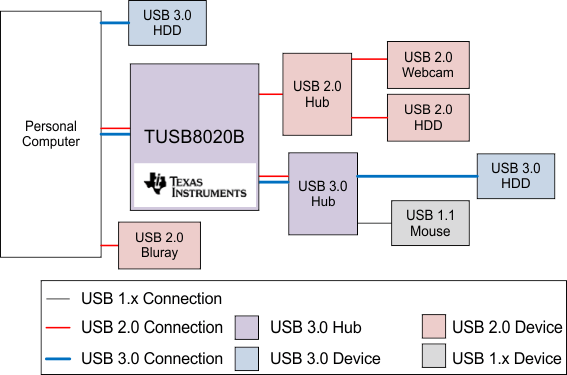SLLSEF6C July 2014 – June 2017 TUSB8020B
PRODUCTION DATA.
- 1 Features
- 2 Applications
- 3 Description
- 4 Revision History
- 5 Description (continued)
- 6 Pin Configuration and Functions
- 7 Specifications
-
8 Detailed Description
- 8.1 Overview
- 8.2 Functional Block Diagram
- 8.3 Feature Description
- 8.4 Device Functional Modes
- 8.5
Register Maps
- 8.5.1
Configuration Registers
- 8.5.1.1 ROM Signature Register (offset = 0h) [reset = 0h]
- 8.5.1.2 Vendor ID LSB Register (offset = 1h) [reset = 51h]
- 8.5.1.3 Vendor ID MSB Register (offset = 2h) [reset = 4h]
- 8.5.1.4 Product ID LSB Register (offset = 3h) [reset = 25h]
- 8.5.1.5 Product ID MSB Register (offset = 4h) [reset = 80h]
- 8.5.1.6 Device Configuration Register (offset = 5h) [reset = 1Xh]
- 8.5.1.7 Battery Charging Support Register (offset = 6h) [reset = 0Xh]
- 8.5.1.8 Device Removable Configuration Register (offset = 7h) [reset = 0Xh]
- 8.5.1.9 Port Used Configuration Register (offset = 8h) [reset = 0h]
- 8.5.1.10 PHY Custom Configuration Register (offset = 9h) [reset = 0h]
- 8.5.1.11 Device Configuration Register 2 (offset = Ah)
- 8.5.1.12 UUID Registers (offset = 10h to 1Fh)
- 8.5.1.13 Language ID LSB Register (offset = 20h)
- 8.5.1.14 Language ID MSB Register (offset = 21h)
- 8.5.1.15 Serial Number String Length Register (offset = 22h)
- 8.5.1.16 Manufacturer String Length Register (offset = 23h)
- 8.5.1.17 Product String Length Register (offset = 24h)
- 8.5.1.18 Serial Number Registers (offset = 30h to 4Fh)
- 8.5.1.19 Manufacturer String Registers (offset = 50h to 8Fh)
- 8.5.1.20 Product String Registers (offset = 90h to CFh)
- 8.5.1.21 Additional Feature Configuration Register (offset = F0h)
- 8.5.1.22 Charging Port Control Register (offset = F2h)
- 8.5.1.23 Device Status and Command Register (offset = F8h)
- 8.5.1
Configuration Registers
- 9 Application and Implementation
- 10Power Supply Recommendations
- 11Layout
- 12Device and Documentation Support
- 13Mechanical, Packaging, and Orderable Information
Package Options
Mechanical Data (Package|Pins)
- PHP|48
Thermal pad, mechanical data (Package|Pins)
- PHP|48
Orderable Information
1 Features
- Two-Port USB 3.0 Compliant Hub, USBIF TID#330000057
- USB 2.0 Hub Features
- Multi-Transaction Translator (MTT) Hub: Two Transaction Translators
- Four Asynchronous Endpoint Buffers Per Transaction Translator
- Supports Battery Charging
- CDP Mode (Upstream Port Connected)
- DCP Mode (Upstream Port Unconnected)
- DCP Mode Complies With Chinese Telecommunications Industry Standard YD/T 1591-2009
- Support D+/D– Divider Mode
- Supports Operation as a USB 3.0 or USB 2.0 Compound Device
- Per Port or Ganged Power Switching and Overcurrent Notification Inputs
- OTP ROM, Serial EEPRO,M or I2C/SMBus Slave Interface for Custom Configurations:
- VID and PID
- Port Customizations
- Manufacturer and Product Strings (not by OTP ROM)
- Serial Number (not by OTP ROM)
- Application Feature Selection Using Terminal Selection or EEPROM/ or I2C/SMBus Slave Interface
- Provides 128-Bit Universally Unique Identifier (UUID)
- Supports On-Board and In-System OTP/EEPROM Programming Through the USB 2.0 Upstream Port
- Single Clock Input, 24-MHz Crystal or Oscillator
- No Special Driver Requirements; Works Seamlessly on any Operating System With USB Stack Support
- 48-Pin HTQFP Package (PHP)
2 Applications
- Computer Systems
- Docking Stations
- Monitors
- Set-Top Boxes
3 Description
The TUSB8020B is a two-port USB 3.0 compliant hub. It provides simultaneous SuperSpeed USB and high-speed/full-speed connections on the upstream port and provides SuperSpeed USB, high-speed, full-speed, or low-speed connections on the downstream ports. When the upstream port is connected to an electrical environment that only supports high-speed or full-speed/low-speed connections, SuperSpeed USB connectivity is disabled on the downstream ports. When the upstream port is connected to an electrical environment that only supports full-speed/low-speed connections, SuperSpeed USB and high-speed connectivity are disabled on the downstream ports.
The TUSB8020B supports per port or ganged power switching and overcurrent protection.
An individually port power controlled hub switches power on or off to each downstream port as requested by the USB host. Also when an individually port power controlled hub senses an overcurrent event, only power to the affected downstream port will be switched off.
A ganged hub switches on power to all its downstream ports when power is required to be on for any port. The power to the downstream ports is not switched off unless all ports are in a state that allows power to be removed. Also when a ganged hub senses an overcurrent event, power to all downstream ports will be switched off.
Device Information(1)
| PART NUMBER | PACKAGE | BODY SIZE (NOM) |
|---|---|---|
| TUSB8020B | HTQFP (48) | 7.00 mm × 7.00 mm |
- For all available packages, see the orderable addendum at the end of the data sheet.

4 Revision History
Changes from B Revision (March 2017) to C Revision
- Added SMBUS Programming current to the Hub Input Supply Current tableGo
- Added Note to the SMBus Slave Operation sectionGo
Changes from A Revision (July 2014) to B Revision
- Replaced the Absolute Maximum Ratings tableGo
Changes from * Revision (July 2004) to A Revision
- Changed device status to production data Go